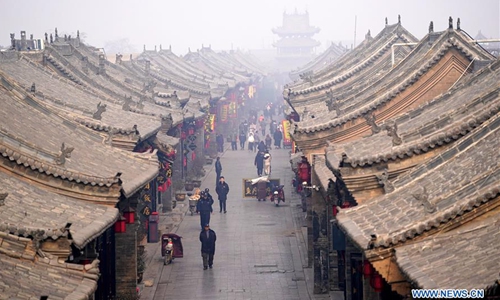ARTS / CULTURE & LEISURE
China’s support and contribution to UNESCO

Tourists visit the ancient city of Pingyao in Jinzhong, north China's Shanxi Province, on Dec. 25, 2019. Pingyao, a UNESCO World Cultural Heritage site in north China's Shanxi Province, is famous for its well-preserved ancient architecture including the city walls. The city boomed in the 19th century as China's financial center, as Shanxi merchants expanded their businesses across the country. Now, the well-preserved compounds of these affluent merchants and some emerging modern elements like souvenir shops, bars, photography festival and theatrical performances have again brought the ancient city to life and made it a popular tourist attraction. Photo:Xinhua
Since joining United Nations Educational, Scientific and Cultural Organization (UNESCO), China has cooperated with the organization and supported its activities in several fields and by many channels, as confirmed and recorded by UNESCO.
China is one of UNESCO’s largest governmental funding sources consistently ranking among the top 20 donors providing voluntary contributions, and the largest contributor of assessed contributions to UNESCO’s regular budget, according to documents sent to the Global Times by Clare O’Hagan, Press Attaché of UNESCO.
China is the first contributor to the Regular Budget, with a total of $40,564,315. In 2019, in terms of voluntary contributions, China ranked as the top 12th donor with $6.3 million. This year, China recently committed $ 700,000 to support UNESCO activities, in particular Global Priority Africa, amid the COVID-19 pandemic. The support includes that from Chinese local governments and private sector companies, with some 30 active partnerships, providing a total amount of some $32 million.
China’s support in educational projects
Since 2012, the main focus of the Chinese government’s support has been in the field of education in particular for supporting the capacities of teachers in Africa, through the project entitled “Enhancing teacher education for bridging the quality gap in Africa” which has covered eight beneficiary countries: Namibia, Ethiopia, Cote d’Ivoire, Congo, the Democratic Republic of the Congo, Liberia, Tanzania and Uganda.
The project’s success led to renewed Chinese commitment for scaling up its scope to include Zambia and Togo. The Chinese government provided a fund in total of $11 million to support the project.
In October 2019, UNESCO and the Government of China confirmed their commitment and partnership for supporting education systems in Africa, through the signature of a new four-year agreement of $8 million in support higher technical education.
This new project aimsto support African governments and higher technical institutions in designing updated quality curricula that are gender-sensitive and correspond better to the needs of labor markets and industries.
In October 2019, the UIL had signed an agreement with the Shanghai Open University with three areas: higher education’s contributions to lifelong learning; lifelong learning e-toolkits, and lifelong learning capacity-building. And in April 2020, the UNESCO Institute for Lifelong Learning (UIL) signed a MOU with East China Normal University, in the field of scholarly exchange, joint publication, co-organization of international conference and capacity-building activities, as well as cooperation in research projects.
The UNESCO-Chinese Funds-in-Trust projects of the Municipality of Shenzhen on quality control in higher education in Africa and Asia total $2 million, of which $1.5 million was earmarked for the African continent from 2016 to 2020.
The UNESCO Confucius Prize for Literacy was established in 2005, to recognize individuals, governments and non-governmental organizations who work in literacy amongst adults in rural areas and out-of-school youth, particularly women and girls. Every year, the prize is awarded to three laureates on International Literacy Day.
The prize was renewed for five years in 2016, with an increased yearly contribution from China of $200,000. As the current cycle will be ending this year, a new evaluation will be conducted for the 2016-2020 period, to be presented at the 2021 spring session of the Executive Board, for China’s consideration of a renewal.
China’s contribution on cultural activities
China has 55 World Heritage Sites ranking top in the world along with Italy and 40 world intangible cultural relics
The 44th World Heritage Convention was originally scheduled for June 29 to July 9 2020 in Fuzhou, East China’s Fujian Province, but was postpone due to the COVID-19 epidemic.
According to the statistics from UNESCO, China has provided an additional contribution of $795,000 in relation to the organization of the 44th session under the Host Country agreement.
China has offered to host the 7th Meeting of the Inter-governmental Coordinating Committee on Serial Transnational World Heritage Nomination of the Silk Roads, scheduled for spring 2021. Professor Zhou Lyu, Director of the National Heritage Centre of Tsinghua University, is currently the co-chair of the Coordinating Committee.
UNESCO, in collaboration with the African World Heritage Fund and the National Commission of China, organized the UNESCO-Africa-China Forum on World Heritage Capacity Building and Cooperation, at the headquarters of the organization from June 3 to 4 2019.
This provided an opportunity for African and Chinese government officials to share views and concerns regarding the challenges and opportunities for sustainable development of World Heritage properties.
Other fields
Aside from education and culture, the Chinese government and private sector have contributed to a number of UNESCO Silk Road projects, including the Silk Roads Online Platform, the Interactive Atlas of Cultural Interactions along the Silk Roads and the “Youth Eyes on the Silk Roads” International Photo Contest, which had an exhibition organized at the Conference on Dialogue of Asian Civilizations in Beijing on May 15 2019.
The International Youth Forum on Creativity and Heritage along the Silk Roads, Special Dialogue on Youth’s Action and Commitment in the Context of the COVID-19 pandemic (IYFSD) took place on May 20 2020 and convened 120 alumni, from 68 countries of the three past International Youth Forum on Creativity and Heritage along the Silk Roads (IYF).
The IYFSD was jointly organized by UNESCO Beijing Cluster Office and the Chinese National Commission, with the Nanjing and Changsha municipal governments. This Special Dialogue showcased concrete actions taken by young people in response to the pandemic and encouraged further engagement that benefits their communities and societies.
UNESCO opened a social media account on China’s Twitter-like Sina Weibo, leading or joining in some social media campaigns with Chinese netizens.
A UNESCO-led UN joint campaign on combating COVID-19-related racism and xenophobia has sparked a high level of public attention in China with 13.5 million views on UN social media channels and almost 9 million views on Sina Weibo.
As Qu Xing, Deputy Director-General of UNESCO, said on the occasion of the Reception for the 70th anniversary of the People’s Republic of China, the cooperation between UNESCO and China, which the Director-General described as a strategic partner, has notably intensified in a number of areas in recent years.
Qu said that if UNESCO and China are working increasingly closer, it is because they both attach fundamental importance to multilateralism.
Whether it is access to education, climate change or the technological revolution, solutions must also be global and coordinated between all countries and regions, he said.
“It is multilateralism that offers us a framework for a coordinated response – a framework that reminds us that we are all brothers and sisters in humanity,” Qu noted.

